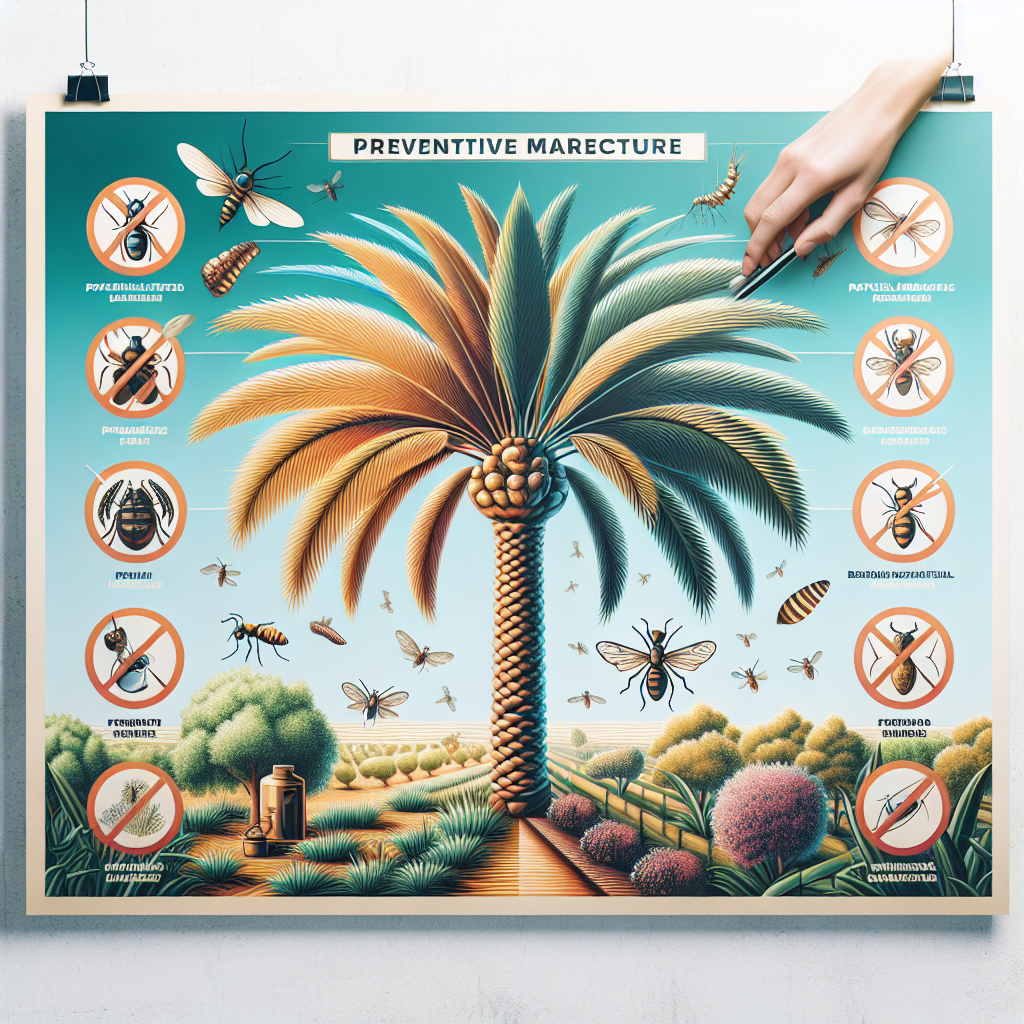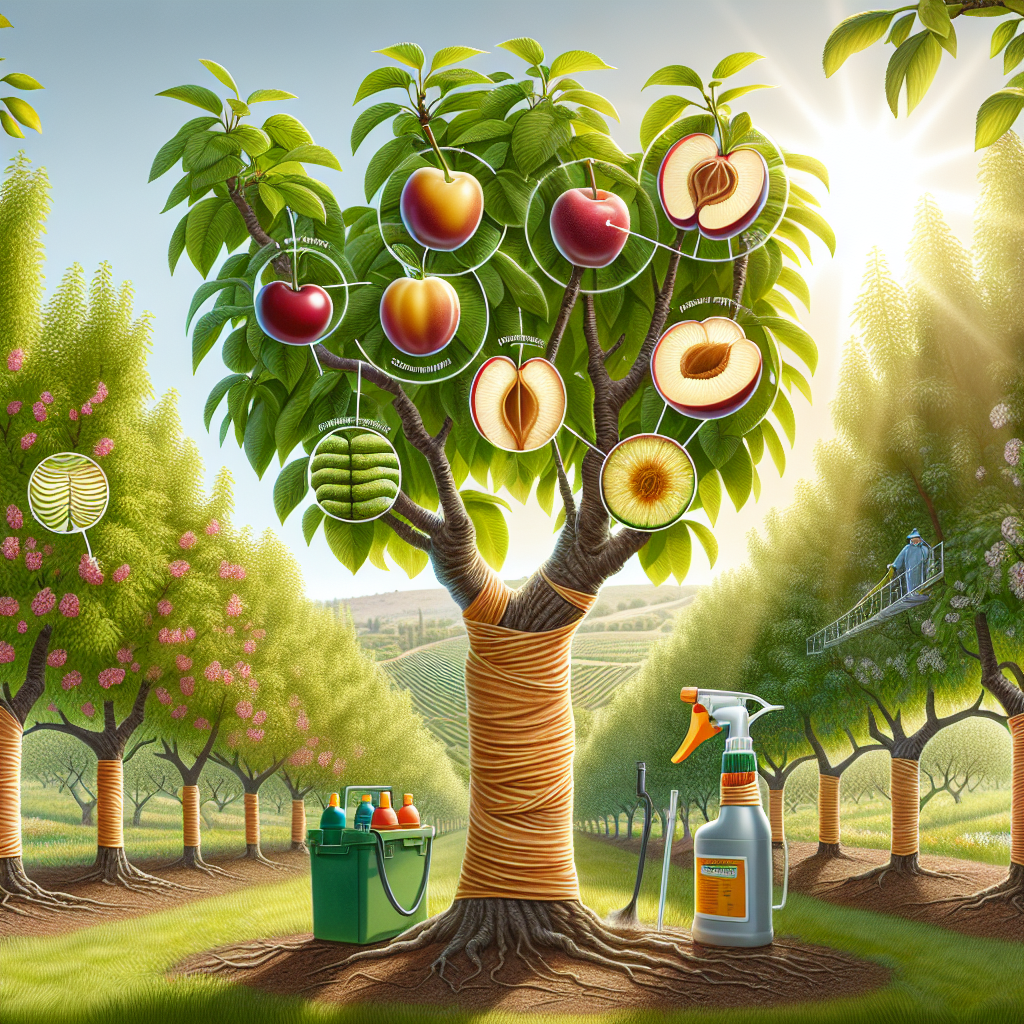Preventing Canary Island Date Palm Weevil
Published April 4, 2024 at 11:20 pm
Explore effective strategies to safeguard the majestic Canary Island Date Palms from the devastating impacts of the invasive weevil, ensuring the preservation of these iconic trees for future generations.

Understanding the Threat: Canary Island Date Palm Weevil Overview
Pest Identification: The Canary Island Date Palm Weevil, also known as Rhynchophorus ferrugineus or Red Palm Weevil, is a notorious pest that conspicuously targets palm species, including the prized Canary Island Date Palm. Notorious for its destructive larvae which bore into the heart of palms, this weevil’s presence is discernible by telltale signs of infestation such as wilting, yellowing fronds, and a decline in the tree’s vigour.
Infestation Indicators: Early detection is key, and you might observe an unusual amount of insects around the palm crown, or a fermented odor due to the weevil’s activity. Looking closely might even reveal holes and tunnels in the trunk where larvae have entered, creating detrimental impacts on the palm’s structural integrity and health.
Preventative Measures and Cultural Practices
Regular Inspections: Diligent monitoring of your palms is crucial. By regularly inspecting and spotting initial infestation signs, you could intercept before significant damage occurs. Be especially vigilant for any changes in foliage color or texture, as these could be early distress signals from your palm.
Sanitation: Maintaining cleanliness around your palm trees cannot be emphasized enough. Ensure timely removal and disposal of dead leaves or debris, which may harbor weevil eggs or larvae. Practicing good sanitation will make your garden less inviting to these unwanted guests.
Chemical Control: Using Insecticides Wisely
Insecticide Selection: For controlling weevil populations, consider specific insecticides known for their effectiveness against palm pests. Always opt for products with a proven track record, and observe all safety measures and application instructions provided by the manufacturer.
Application Techniques: The efficiency of insecticide use lies in correct application. Focusing treatments on the crown and trunk, where weevils typically infiltrate, increases chances of reaching the larvae nestled within. Always follow the recommended dosage and frequency to ensure optimal results without harming your palm.
Find This and More on Amazon
Biological Control: Leveraging Natural Weevil Enemies
Parasitic Controls: Introducing natural predators or parasitoids that target the red palm weevil larvae can be an eco-friendly solution. Although slower to show results than chemical treatments, they deliver a long-term, sustainable control method without the environmental impact of insecticides.
Microbial Insecticides: Certain bacteria, like Bacillus thuringiensis, produce toxins deadly to specific insects but harmless to humans and wildlife. These bio-insecticides offer a targeted and safer alternative to conventional chemical treatments.
Mechanical Controls: Physical Barriers and Traps
Physical Barriers: Installing barriers around the trunks of palms can discourage adult weevils from laying eggs. These may also protect against other climbing pests, serving a dual function in pest management.
Using Pheromone Traps: Pheromone traps attract weevils through synthetic hormones mimicking those emitted by females. Once trapped, the cycle of infestation circumvents, reducing the population. A well-placed pheromone trap can be quite effective when used as a part of an integrated pest management strategy.
Cultural Interventions: Enhancing Palms' Health
Proper Fertilization: Healthy palms are less likely to succumb to pest attacks. An appropriate fertilization regime tailors to the specific needs of your palm species which can enhance their ability to withstand and recover from weevil damage.
Optimized Watering Practices: Overwatering or under-watering can both stress palms, making them more susceptible to pests like the Canary Island Date Palm Weevil. Establish regular and deep watering routines to promote a strong and resilient root system.
Landscaping Considerations for Weevil Prevention
Strategic Planting: When planting Canary Island Date Palms, consider their spacing and location. Palms planted too closely may inadvertently facilitate the spread of pests from one tree to another. Additionally, situate new palms away from infested areas to prevent contamination.
Diverse Plant Selection: Creating a diverse ecosystem in your landscape can discourage pest establishment. Biodiversity often begets natural pest control mechanisms but consult a comprehensive guide to establishing pollinator-friendly gardens for insights into sustainable planting practices that support this philosophy.
Long-Term Strategies for Weevil Management
Community Involvement: Pest management is most successful when tackled collaboratively. Engage with local agricultural extensions or neighborhood gardening clubs. Collective vigilance can detect and prevent large-scale outbreaks more effectively than solitary efforts.
Continued Education: Stay informed about the latest findings regarding the Canary Island Date Palm Weevil. Winter gardening tips might not directly correlate, but the philosophy of continuous learning applies universally across gardening practices.
Case Studies: Learning from Experience
Success Stories: Case studies where integrated pest management has succeeded can offer valuable lessons, providing replicable models for weevil prevention and control. Understanding the methodology behind successful interventions assists in crafting your own defensive strategy.
Adaptive Measures: Review the outcomes where strategies required adaptation due to a change in weevil behavior or environmental conditions. Adaptability is a critical factor in long-term pest management success.
Resources and Support: Where to Turn for Help
Professional Assistance: Sometimes the scale of infestation calls for professional help. Certified arborists or pest control agents possess the expertise to diagnose and remedy severe weevil problems effectively and safely.
Online Forums and Communities: There’s a wealth of knowledge to be found in online gardening communities. Sharing experiences can uncover new insights and foster a broader understanding, such as how growing Boston ferns indoors benefits air quality, thereby indicating the interconnectedness of indoor and outdoor plant health.
Understanding Weevil Life Cycles for Better Management
Life Cycle Knowledge: Grasping the life cycle of the Canary Island Date Palm Weevil offers significant insights into controlling their population. Adult weevils lay eggs in palm tissue, and hatched larvae feed on the tree from inside, making early lifecycle stages the best targets for intervention.
Optimal Timing for Control: Effective control hinges on timing. Treatments should coincide with vulnerable phases of the weevil’s development, such as when larvae are most active or when adults are mating. This ensures that interventions are as impactful as possible.
Diagnostic Techniques: Spotting Infestation Early
Acoustic Detection: One innovative approach used to identify weevil presence is acoustic monitoring. The sound of larvae burrowing through palm tissue can be picked up with sensitive equipment, providing an early warning sign before visual symptoms manifest.
Thermal Imaging: Thermal cameras can detect heat patterns caused by weevil activity within the trunk. This non-invasive method pinpoints infestations without damaging the palm and aids in targeted application of control measures.
Organic Control Options
Natural Insecticides: Neem oil, extracted from the neem tree, is a natural insecticide that can deter weevil activity. Its application provides a less toxic alternative to synthetic chemicals and is generally considered to be safe for beneficial insects and mammals.
Soil Health Management: Enhancing soil quality strengthens palms from the roots up. Utilizing organic compost and mulches can improve root health and the overall vigor of the palm, equipping it to naturally fight off pest invasions like those of the weevil.
Nurturing and Strengthening Palms for Resistance
Resilient Varieties: Opt for palm varieties recognized for their resilience to pests where possible. Certain species or cultivars might display natural resistance to weevils, offering an inherent defense mechanism against these pests.
Prudent Pruning Techniques: Prune correctly to avoid creating unnecessary wounds that can attract weevils. Clean cuts heal faster and are less inviting to pests. Always sanitize your pruning tools between uses to prevent the spread of pests and diseases.
Regulatory Measures and Compliance
Understanding Quarantine Protocols: In areas where the Canary Island Date Palm Weevil is a known threat, authorities might enforce quarantine measures. Compliance with these regulations is crucial to prevent the spread of weevils to new areas.
Reporting and Documentation: If you spot signs of an infestation, report them to local agricultural authorities to assist them in tracking and managing the spread of weevils. Accurate reporting also contributes to the communal effort to control this pest.
Reviewing Common Misconceptions About Weevil Management
Myth Busting: It’s easy to fall prey to misconceptions, such as believing the weevils cannot infest healthy palms. In reality, healthy trees can still be victims, which is why proactive prevention is so important for all palms.
Overreliance on Chemicals: Excessive dependence on chemical treatments can lead to resistance in pest populations. Integrated Pest Management (IPM) strategies are essential to outmaneuver such challenges.
Innovative Approaches to Weevil Control
Tapping into Tech: Emerging technologies like drones offer a new way to monitor large palm populations for signs of weevil activity, providing a bird’s eye view that might not be apparent at ground level.
Genetic Research: Scientists are studying the weevil’s genetics in hopes of developing new control methods, like targeted biological controls that can disrupt the weevil’s reproduction or development without affecting other species.
Staying Ahead of the Curve: Monitoring for Future Threats
Global Trends: Understanding global trends in pest management can be invaluable. With climate change altering habitats, new pests might emerge, requiring vigilance and adaptability in response strategies, much like ensuring that Alocasia plants are cared for correctly in changing indoor environments.
Continual Learning: The field of pest control is always evolving. By staying informed about advances in the field, you can adapt your management practices to be more effective in preventing and controlling outbreaks of the Canary Island Date Palm Weevil.
Personalizing Your Weevil Management Strategy
Your Palm Profile: Take stock of the specific conditions that affect your palms. Consider factors such as climate, palm species, and existing health issues to create a tailored weevil management strategy that addresses the unique needs of your environment.
Resource Allocation: Depending on the size of your palm collection and the extent of the weevil threat, your approach to management should balance efficacy with practicality, aiming to prioritize resources where they’ll have the greatest impact.
Final Thoughts on Weevil Prevention and Control
Integrative Approach: The key to successfully preventing and managing Canary Island Date Palm Weevil infestations is a multifaceted approach that combines inspections, cultural practices, mechanical, chemical, and biological controls, all tailored to your specific situation and environment.
Proactive Partnerships: Collaborating with fellow gardeners, local experts, and regulatory bodies amplifies your efforts and fosters an environment where educational growth and community support thrive, enhancing the collective ability to safeguard palms from the Canary Island Date Palm Weevil.
“`html
Exploring Natural Weevil Repellents
Essential Oils: Some gardeners swear by the repellent properties of certain essential oils, like eucalyptus or lavender. Applied around the base of the palm, they may deter weevils from approaching. Remember though, the effectiveness of natural repellents can vary widely, and they should be used in conjunction with other control methods.
Companion Planting: Companion planting can be a smart move in your weevil defense arsenal. Some plants can naturally repel pests or attract beneficial insects that prey on weevils. Research which companion plants work best with your landscape to fortify it against potential threats.
Incorporating Weevil Resistant Palms
Selective Breeding: Some nursery growers are focusing on breeding weevil-resistant palm varieties. If you’re planning to plant new palms, it’s worth considering these options. While research in this area is ongoing, the promise of a palm variety that naturally resists weevils is an exciting development.
Placing Resistant Varieties: By placing resistant varieties more prominently, you can create a less hospitable environment for weevils. This strategy can be particularly effective in areas where these pests are a common problem.
Practical Tips for Homeowners Facing Weevils
Garden Hygiene: Simple habits like regularly cleaning up garden waste and avoiding over-clumping of plants can play a big role in making your garden less attractive to weevils. Unkempt areas can provide the perfect breeding ground for pests, including the Canary Island Date Palm Weevil.
Education on Signs: Knowing what to look for can give you a headstart in combating a weevil invasion. For example, drooping fronds or sawdust-like frass near your palms might indicate a problem. If you stay vigilant and react quickly, you can mitigate the damage significantly.
Understanding Integrated Pest Management (IPM)
Combining Techniques: IPM is all about combining various methods for controlling pests in the most environmentally sensitive way. This might involve starting with cultural and mechanical controls and using chemical solutions as a last resort.
Regular Evaluation: IPM isn’t a set-it-and-forget-it approach. It requires regular evaluation of what’s working and what’s not. By keeping tabs on the effectiveness of each control method, you can adjust your approach to manage and prevent weevils more effectively.
Update on Canary Island Date Palm Weevil Research
Latest Findings: Stay abreast of the latest research on weevil behaviors and control methods. Current studies might offer novel insights into detection, prevention, and elimination of this pest which could be invaluable for ensuring the health of your palms.
Participation in Studies: If you can, participating in local research studies or trials can be a great way to contribute to the body of knowledge on weevil management while possibly benefiting from the latest prevention methods.
When to Consider Professional Weevil Control Services
Assessing the Situation: Sometimes, despite your best efforts, you might need to call in the pros. If the infestation is too widespread or too advanced, professional pest control services will have the necessary tools and expertise to manage the situation effectively.
Choosing the Right Service: Invest time in finding a reliable and experienced pest control service. Look for companies with specific experience in managing palm weevils. Reading reviews and asking for recommendations can lead you to a service provider well-equipped to tackle your weevil woes.
Documentation and Record Keeping
Importance of Records: Keeping detailed records of what you observe and the steps you take can be a powerful tool in managing weevils. This documentation can help you track progress, understand patterns, and refine your approach over time.
Sharing Knowledge: Your records can also be valuable to the broader community. By sharing your findings with local gardening groups or online forums, you contribute to a larger pool of knowledge that can benefit others facing similar issues.
Conclusion: Taking Proactive Steps Against Weevils
Prevention Over Cure: The old adage about prevention being better than the cure holds true in the case of the Canary Island Date Palm Weevil. By taking proactive steps, such as regular inspections and good cultural practices, you can often prevent significant damage before it starts.
Building a Support Network: Don’t forget, you’re not alone in this fight. Building a network of fellow gardeners, local experts, and trusted resources can provide you with the support and information you need to successfully manage weevil threats.
“`
Shop more on Amazon
Flowers & Plants Team
Flowers & Plants Team


